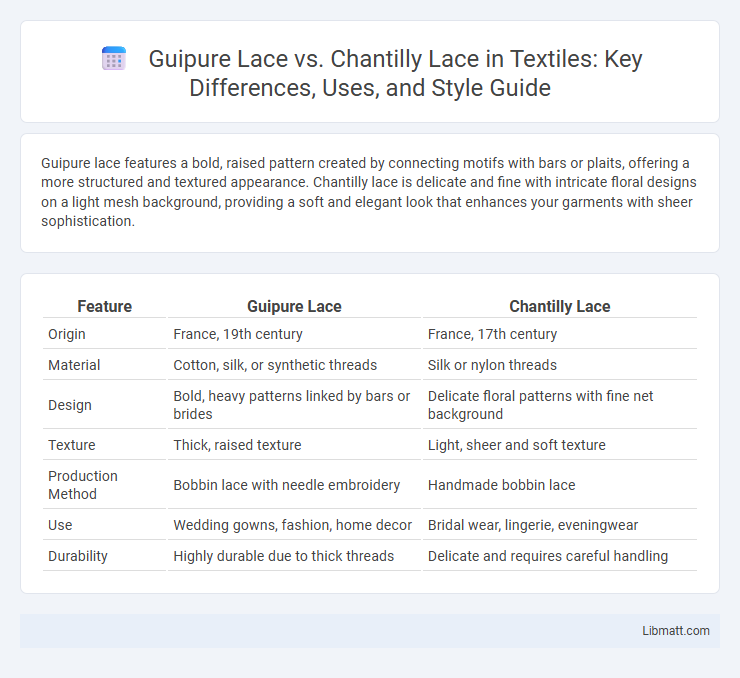Guipure lace features a bold, raised pattern created by connecting motifs with bars or plaits, offering a more structured and textured appearance. Chantilly lace is delicate and fine with intricate floral designs on a light mesh background, providing a soft and elegant look that enhances your garments with sheer sophistication.
Table of Comparison
| Feature | Guipure Lace | Chantilly Lace |
|---|---|---|
| Origin | France, 19th century | France, 17th century |
| Material | Cotton, silk, or synthetic threads | Silk or nylon threads |
| Design | Bold, heavy patterns linked by bars or brides | Delicate floral patterns with fine net background |
| Texture | Thick, raised texture | Light, sheer and soft texture |
| Production Method | Bobbin lace with needle embroidery | Handmade bobbin lace |
| Use | Wedding gowns, fashion, home decor | Bridal wear, lingerie, eveningwear |
| Durability | Highly durable due to thick threads | Delicate and requires careful handling |
Introduction to Lace: Guipure vs Chantilly
Guipure lace is characterized by its heavy, raised patterns linked by bars or plaits, creating a bold and textured appearance ideal for decorative overlays. Chantilly lace features delicate, intricate floral patterns with fine netting background, known for its lightness and elegance often used in bridal wear. Both laces originate from European traditions but serve different stylistic purposes due to their distinct construction and visual impact.
What is Guipure Lace?
Guipure lace is a type of lace characterized by its heavy, raised patterns connected by bars or plaits rather than a net background, creating a bold and textured look. It originated in France and is commonly used in bridal gowns, haute couture, and fashion accessories due to its intricate and durable design. Guipure lace offers a striking contrast to the delicate, fine mesh of Chantilly lace, making it ideal for dramatic and structured garment embellishments.
What is Chantilly Lace?
Chantilly lace is a delicate, lightweight lace known for its fine netting background and intricate floral or scroll patterns created with silk or linen threads. Originating from the town of Chantilly in France, it features a distinct scalloped edge and often incorporates a subtle sheen, making it popular for bridal gowns and elegant evening wear. You'll appreciate Chantilly lace for its soft, airy texture and romantic, detailed designs that contrast with the heavier, more raised motifs found in Guipure lace.
History and Origins
Guipure lace originated in 16th-century Italy, characterized by its heavy, raised patterns connected by bars or plaits without a net background, making it popular for ornate, durable designs. Chantilly lace, developed in 17th-century France, is known for its delicate, fine net background and intricate floral patterns, often crafted with silk threads to create a lightweight, elegant fabric. Your choice between Guipure and Chantilly lace reflects a preference for either bold, textured craftsmanship or delicate, airy artistry rooted in rich European lace-making traditions.
Key Design Differences
Guipure lace features a dense, raised pattern connected by bars or plaits, creating a bold and textured look, while Chantilly lace is known for its delicate, fine net background and intricate floral designs outlined with a heavier thread. Guipure lace typically lacks a net base, giving it a more three-dimensional and structured appearance, whereas Chantilly lace offers a lighter, softer, and more transparent feel. Understanding these key design differences helps you choose the suitable lace style for your garment's desired elegance and texture.
Texture and Material Comparison
Guipure lace features a dense, raised texture made from thicker threads, often cotton or polyester, creating a bold and structured look. Chantilly lace, typically crafted from fine silk or nylon, has a delicate, lightweight texture with intricate floral patterns and a soft, sheer background. Your choice depends on whether you prefer the robust, three-dimensional feel of Guipure or the elegant, airy finesse of Chantilly lace.
Typical Uses in Fashion
Guipure lace is commonly used in bridal gowns and evening wear due to its intricate, dense patterns that add texture and elegance. Chantilly lace, known for its fine, delicate floral designs and lightweight feel, is favored for veils, lingerie, and overlays on dresses to create a romantic and airy look. Your choice between Guipure and Chantilly lace depends on whether you want a bold, structured appearance or a soft, ethereal effect in fashion.
Durability and Maintenance
Guipure lace is known for its thicker, heavier threads that provide greater durability, making it more resistant to wear and tear compared to Chantilly lace. Chantilly lace, characterized by its delicate and intricate floral patterns with fine threads, requires careful handling and gentle cleaning to maintain its delicate beauty. Your choice between these two laces should consider the balance between durability and the level of maintenance you are prepared to undertake.
Price and Accessibility
Guipure lace is generally more affordable and widely accessible due to its machine-made production and thicker, heavier patterns, making it popular for everyday fashion and bridalwear. Chantilly lace, known for its intricate, delicate floral designs and hand-crafted origins, commands a higher price point and is less readily available, often reserved for high-end couture and luxury garments. Both types vary in price depending on craftsmanship and material quality, but Chantilly lace remains the premium choice for exclusivity and elegance.
How to Choose: Guipure or Chantilly
Choose Guipure lace for bold, textured designs featuring heavy embroidery and distinct patterns without a mesh background, ideal for statement garments and bridal overlays. Opt for Chantilly lace when seeking delicate, intricate floral motifs on fine netting, providing an elegant, lightweight appearance perfect for veils, lingerie, and evening wear. Consider the fabric's weight, pattern prominence, and intended garment style to determine whether the strong, raised texture of Guipure or the refined, sheer quality of Chantilly lace best suits your design needs.
Guipure lace vs Chantilly lace Infographic

 libmatt.com
libmatt.com